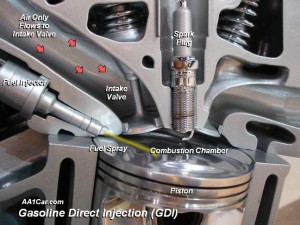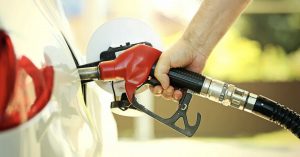If modern cars had the same size gas tanks as cars once had, the range disparity between them an electric cars would be even more startling than it is – and electric cars would look even more ridiculous than they do, to minds capable of appreciating the humor of it.
Most any new or late-model non-electric car can go about 350-400 miles on the highway, on a full tank of gas. This is still significantly farther than most electric cars can travel on a full charge – and the gas-powered car can be ready for another 350-400 miles in just a few minutes, while the electric car will be moored to a “fast” charger for at least 30 minutes – assuming you get there first and don’t have to wait at least 30 minutes for the car ahead of you to “fast” charge.”
And hope it’s not a fiery charge.
But if today’s cars carried more gas, they’d be able to go much farther – and without the bother (or the burn).
Most only carry 12-16 gallons, even V8-powered performance cars like the current Ford Mustang GT. Its 16 gallon tank – which would appropriate for an economy car – serves to reduce its highway range to 449.5 miles. That still gets you much farther down the road than you could travel in even the “longest range” electric cars, like a Tesla equipped with its optional (and costs-you-several-thousand-dollars-more) higher-capacity battery pack, which increase the car’s maximum range to 353 miles (but does nothing to reduce the wait – or the risk of a fire).
Most “gas hogs” can go farther – more cheaply and easily – than any energy hog electric car. They could go a lot farther, too – because unlike electric cars, it would be easy and cheap to increase their range – by the simple expedient of increasing the size of their tanks.
If the current Mustang GT had an appropriate-sized tank, which would be around 20-21 gallons – as was once typical for a car of this type (like this writer’s generally similar 1976 Pontiac Trans-Am) it would have a highway range in excess of 500 miles, without significantly adding to the cost of the car – which could still also be refueled in minutes without any increased risk of fire, unless you did something really stupid such as light a match.
Most current economy cars would feel a lot more economical, too, if they carried 15-18 gallons rather than the now-usual 12. A car that got say 40 miles-per-gallon could travel more than 700 miles on a full tank. And if the car were diesel-powered and averaged 50 miles-per-gallon and had an 18 gallon tank, you’d be good to go for 900-plus miles.
So why do most modern cars carry so little gas?
The ironical answer is – once again – because of government working so very hard to “save you money” . . . on gas. I wrote earlier (here) about the effect of government fuel efficiency regulations – which is a nice way of saying, federal decrees ordering new car manufacturers to squeeze some arbitrary and ever-increasing number of miles-per-gallon out of every car they make.
“Compliance” – as it is styled – can be achieved expensively and so overtly via technology, as via such technologies as direct injection (rather than less complex and less expensive port fuel injection) and ten and nine speed transmissions with several rather than just one overdrive gear. These technologies have added hundreds and even thousands to the cost of a new car, which would otherwise cost less rather than more due to increases in manufacturing efficiencies, economies of scale and so on.
Government also costs you via obvious annoyances, such as ASS – the automatic stop/start “technology” afflicting almost all new cars that automatically turns off the engine at every red light, then spins it back on – after a noticeable pause and a noticeable sensation and sound – when the driver pushes on the accelerator pedal.
But the subtler way government duns you – indirectly – is by pressuring the car manufacturers to shave weight wherever possible, which costs you in ways you don’t see as easily – as I got into in my previous article on this topic. As via extremely thin body panels that cost you in the form of being much more susceptible to damage (and thus, impart higher insurance premiums). As via lightweight parts – like thin steel brake rotors and aluminum engine blocks – that must be replaced rather than machined when they wear out.
And via a gas gauge needle that goes toward empty, sooner – and a car that makes you stop for gas, more often.
Gas being heavy, you see.
12-16 gallons (in a plastic tank) weighs considerably less than 21.5 gallons (in steel). One gallon of gas weighs about 6 pounds, so the difference between 16 gallons and 21 gallons amounts to about 30 pounds – and while that may not sound like a lot of weight to you, it is the equivalent difference of going from a cast iron to an aluminum cylinder head, which is another thing practically every new car features. And because they do feature them – as well as paper-thin body panels and in many cases, aluminum bodies, the car companies are running out of weight-saving ideas.
Hence the smaller (and plastic) gas tanks.
Cars – sedans, especially – have also gotten smaller and so there’s simply less room underneath for a larger tank. And the tanks must be designed around the various “safety” regulations, which constrain shape and location to a degree that they didn’t, when most cars carried around 20 gallons of gasoline.
Hence the artificially-decreased range of today’s non-electric cars. Which serves to make electric cars seem slightly less ridiculous as practical cars.
The irony here is that while Herculean efforts are exerted toward overcoming the electric car’s inherently gimped range via very expensive – and inherently dangerous – “fast” recharging systems, increasing the range of non-electric cars could be achieved at almost no cost and without the slightest increase in danger.
Of course, that begs the question about why so much effort is being exerted to push electric cars onto the market, when more efficient, practical and affordable alternatives already exist and could be made much more so.
*Thanks to reader Brian M for inspiring this article!
. . .
Got a question about cars, Libertarian politics – or anything else? Click on the “ask Eric” link and send ’em in! Or email me at [email protected] if the @!** “ask Eric” button doesn’t work!
If you like what you’ve found here please consider supporting EPautos.
We depend on you to keep the wheels turning!
Our donate button is here.
If you prefer not to use PayPal, our mailing address is:
EPautos
721 Hummingbird Lane SE
Copper Hill, VA 24079
PS: Get an EPautos magnet or sticker or coaster in return for a $20 or more one-time donation or a $10 or more monthly recurring donation. (Please be sure to tell us you want a magnet or sticker or coaster – and also, provide an address, so we know where to mail the thing!)
My eBook about car buying (new and used) is also available for your favorite price – free! Click here. If that fails, email me at [email protected] and I will send you a copy directly!












Thanks for answering my question in Q&A and for elaborating here in this article.
Seeing the issues around Hurricane Ida in Louisiana reminded me of when I used to live down there. Lots of people who live in hurricane prone areas learn to not let their tanks go past about 1/2 empty before filling up when it’s hurricane season in case you need to get out of town and all the local gas stations are empty (this has happened to me more than once, but thankfully I had taken my own advice). One of f the big issues with Ida, though, was massive power outages across a large part of southeastern Louisiana. No electricity means no functioning gas stations and, certainly, no electric car charging.
Larger fuel tanks are a common upgrade for heavy duty pickups used for towing a lot. A typical diesel pickup these days gets around 18-20mpg when unladen but will dip to about half of that when towing 10,000+ lbs. They usually come equipped stock with a 31+ gallon fuel tank, but aftermarket replacement tanks that slot in where the factory tank is, use the factory fuel pump, and can give you around 60-68 gallons total, roughly doubling your capacity and returning your range to around 600 miles while towing. (Look up S&B fuel tanks). Similarly, Long Range America offers auxiliary fuel tanks for a variety of vehicles including Jeep Wrangler where you can augment the stock 21.5 gallon fuel tank with an additional 17 gallons, nearly doubling the range. This is helpful when one modifies one’s Jeep for heavier off-road use and the stock tank only gets you about 250 miles or range on a tank getting about 13mpg or less on the highway. Both companies’ products are DOT approved, BTW, and other companies make similar products.
Average mpg seems to have gone up over the past 40 years, but fuel tank size has generally shrunk, balancing out the range to around 400 miles, give or take. Today’s cars are much heavier, due to mandated safety equipment mostly, so the fact that fuel efficiency is actually slightly improved on average is a testament to capitalism’s ability to adapt to both real and artificial challenges. I just can’t help but imagine an automotive industry unhindered by regulation producing lighter but safer vehicles capable of 50+ mpg while delivering great performance. One of the problems with safety regulation, as with all regulation, is that it handcuffs inventors. Mandate an air bag in every car, and there is little incentive to develop new safety technology that is both cheaper and superior to air bags. Mandates tend to freeze development, not encourage it.
Yeah: I have 2020 F150, 8ft bed. It has a 23 gallon tank. They do offer the 36, which I will get installed later. Big ass honkering truck, should have at least a 40 gallon tank. My 98 E150 had a 36, which was nice on trips to FL.
“Government also costs you via obvious annoyances, such as ASS – the automatic stop/start “technology” afflicting almost all new cars that automatically turns off the engine at every red light”
ASS, indeed.
Should be prefixed by the word “jack.”
From a CNN Business article about the Mercedes-AMG EQS:
“Mercedes designers also created special sounds for what would otherwise be a largely silent driving experience. The sound, which is generated both inside and outside the vehicle, can vary depending on the driving mode, such as Comfort, Sport or Sport+. In Sport, it’s a gentle hum with an added jet-like overtone during acceleration. In Sport+ it takes on a subtle rumble suggestive of an internal combustion engine.”
How sad is that?
It’s like pretending you’re driving.
So gas powered cars have to lose weight to “extend range”, while an EV has to GAIN weight (batteries) to also “extend range”? Wow! I never knew EV’s were immune to the laws of physics.
Hi Blue,
Well, gas-powered cars can more easily “extend range” by the simple expedient of increasing the size of their gas tanks. EVs can only achieve a degree of the average gas-powered car’s range via increasing the capacity of their batteries, but in this case it’s a case of diminishing returns as the weight of the higher-capacity battery has the effect of decreasing range and increasing cost hugely.
My ‘94 F-150 2WD V6 stick shift had 2 20 gallon tanks and a button on the console to switch between them. I remember going from NJ to Tampa, FL and stopping once for gas back in ‘95. I also remember filling both tanks for around $40 in ‘98 or so (<$1 gas woo hoo!).
Anyone else see the line of cars sitting on the road, trying to escape the CA forest fires?
What would happen in those thousands of cars were electric?
Has no one in govt though of the difficulty of people driving EVs attempting to flee a natural disaster would encounter? I believe they have. And still they consider it worth the risk of dying on the highway fleeing from a fire or hurricane to “save the planet”???
Dan,
TPTB don’t give two shits about you, or me, or anyone else. Just themselves, their power, & their money. Our deaths, much less our inconvenience, will go completely unnoticed as far as they are concerned.
I bet evs caused a couple of wild fires. Catayletic converters have caused many wild fires too..
But cars go as far today as 90s cars cause of mpg.
Hi Anon,
Actually, cars go less far today than they did in the ’90s. As an example, a half-ton Chevy pickup from the early ’90s with a small block V8 and a five speed manual transmission – remember when trucks still offered them? – was capable of 30 on the highway, within a few MPG of a current four cylinder-powered mid-sized sedan.
Today’s cars have very “efficient” engines but their mileage is mediocre – because of their weight. Which is due to government.
Every modern Mustang owner I know complains about the small fuel tank. Quite a few car reviewers note it as well but of course never note why they are.
Another issue with small tanks. I like to fill when the prices are lower (duh) which leaves days like labor day and July 4th out (since prices are always higher on those days). I am on a quarter tank right now, hoping the price goes down a bit later this week. Would be nicer to have a bigger tank so i could fill more when its cheaper.
Also when you traveling a bigger tank comes in handy when you have to pass through a state with high gas taxes (like Illinois) and prices. Unless your going direct east west, its hard to get past Illinois on one tank. And yes, I avoid spending money in Illinois to begin with. Taxes are high in Indiana, but insanely worse in Illinois.
Big tank also useful for driving through NJ, where you aren’t allowed to pump your own gas and have to wait for the kid with the bad attitude to saunter over when he feels like it to fill your tank.
Yet ANOTHER reason for me to flee Doitey-Joisey! Can’t get anymore liberal than forcing us to wait for “Ahmed” to grab the nozzle (and of course, “Ahmed” doesn’t like counting coins, so when the pumps stops at $45.20, he has to OVERFILL the tank so it lands on $46.00)! God, I miss living in SC!
Hi Bluegrey,
Yup – and Ahmend will slosh gas all over your car’s paint, too. That alone would prompt me to flee Joisey, ‘dere . . . if I had the bad luck to live ‘dere!
You let them pump your gas? I just get out and DIY, only person to ever complain was a literal retard they employed there, otherwise they just ask if you’re good and go back.
Why doesn’t anyone make bigger fuel tanks now?
Basically THEY do whatever They desire…
Just leaving a picture for the next diaper report:
https://i.postimg.cc/8CLrXKVQ/Motorcycle-masking.jpg
‘the difference between 16 gallons and 21 gallons amounts to about 30 pounds’ — eric
For a 6-foot man, 30 lbs is about the difference between a Body Mass Index of 25 versus 30.
Great fuel economies could be achieved, in other words, by putting the population on an enforced low-calorie diet via rationing.
Doubtless plans are in the works as we speak. ‘Your vaccine passport and your food ration card, bitte.
Back in the day i had an 88 T Bird with the V8 engine. It had a 20 gallon tank that could get 25+MPG. Many a time in college i would fill up in lincroft nj and not have to fill the tank again until i hit Burlington NC which is slightly more than 500 miles. I still miss that car. Today my V-6 Tacoma has an 18 gallon tank and max i can squeze out of it is about 23 MPG. Normally its closer to 20. But i will still take it over any moving electric appliance they make.
The 1941 Nash “600” (an early unibody car) was so named due to its ability to travel 600 miles on a 20-gallon tank of gasoline. To be fair that would have been at pre-interstate speeds with a manual trans plus overdrive, but still it was done with a simple flathead six-cylinder engine and a carb.
We just had the rotors replaced in my wife’s 2016 Explorer. $500.
Thanks to your article last week, I knew what the dealer would tell my wife even before she dropped off the car complaining about the wobble coming from the front wheels when braking from higher speeds.
As for gas tank size, the Explorer’s tank could be bigger at 16 gallons, but, unlike my 2018 Camry, the “low fuel” light does not activate with two gallons left in the tank.
I was pleasantly surprised when I bought a ’20 Ram last summer and the options page said it had a 33gal tank. Std. in Ram is 26. I didn’t even know the larger tank was avail. After she broke in a little, I see 500+ range on the trip screen. Nice. If I were just doing highway I’m guessing I would see 600.
I’ve been doing some towing lately (6-7Klbs) and mpg dropped to 10-12, and range down to 300+/-, so now I know why when these trucks are optioned as a tow rig, the 33gal tank is desired.
Don’t forget the huge mileage penalty forced crash and emissions standards have on vehicle design. Crash standards guarantee a heavier vehicle with a blunt, tall front end and high R&D costs for saaaaaaafety. Overbearing emissions standards cause bassackwards designs like catcons that require the engine to run rich in order to burn the excess fuel in the exhaust to convert evil gasses into the new evil greenhouse gasses CO2 and water vapor. So instead of your Gaia rape juice moving you down the road it gets uselessly used to heat your exhaust system and possibly cause fires.
Imagine a lightweight commuter, tube framed and clad with the flexible body panels of an old saturn or offroad ATV, powered with a small motorcycle engine. It would be simple, extremely lightweight, rust and dent proof and use very little resources in manufacture and operation. We can’t have it though because the cocksuckers with unlimited funds and resources available to themselves know whats best for us.
I once considered doing hot shot hauling as a post retirement activity. Guys that get their trucks customized usually add an air compressor (air ride suspension / hitch) and a second 30-50 gallon fuel tank. No idea what kind of MPG those guys get but guarantee they’ll ride way further on a tank(s) of go go juice than the kia sportage.
“that begs the question about why so much effort is being exerted to push electric cars onto the market”
It’s quite simple. They want you out of your car. On foot, bicycle, or public transportation. Following THEIR rules about where you go, how often you go, how far you go, and even what time you leave. All the while keeping close tabs on all of the above.
John, I agree with your thinking, but why do they want this outcome? Why limit our ability to travel? What do they gain? Do they really believe this climate BS, or is there something more sinister afloat?
Oscar,
It’s called control. The ptb want full and total control over our lives. Where we live, what we eat, where we work, how we move, etc. They can’t control us while we have the freedom to travel 700 or more miles in a day any place we may want to go in a gas powered car.
Bingo! You can’t have your slaves just picking up and going where they damn well please whenever it damn well pleases them.
My ‘82 Chevy Silverado with a 6.2 diesel engine has two 20-gallon tanks. It’s geared for towing, but if I put taller gears on the rear end I could easily get 20 miles to the gallon x 40 gallons = 800 mile range. I’ve heard of guys retrofitting rear gas tanks from a squarebody ‘burb or blazer and getting another 30 gallons, but seems like a lot of fuel to be hauling around at that point unless you’re some kinda doomsday prepper
As I just spotted this article on Zerohedge: “Tesla Reportedly Targeting $25,000 “Model 2″ With No Steering Wheel By 2023”. And that’s one ride I sure don’t want to get on at the county fair….
Hi, lots of good points here. A quick check shows a factory 1968 Camaro gas tank at 18 gallons and a 2022 at 19 gallons, but I didn’t check out any other pony car gas tank capacity’s. Rotors are definitely a throw away but labor costs were always a killer if you had to pay to have them turned. Part of the reason might be the use of slip on rotors with hub/ bearing assembly s. With the evil “ethanol” in our gasoline plastic gas tanks will last longer without rusting out especially with limited use vehicles stored in winters. A lot of the other “improvements” like 8 speed transmissions, direct port injection and the like will never save you enough money to ever pay the cost of repairing them. And as for ASS, every time I hear a car starting up at a light my first thought is that the engine stalled. Aluminum body panels means a complete new set of dedicated tools for body repair and techs trained to weld aluminum (more $$$$$) of course and a little more likely to dent (I wonder if they will dissolve in the winter salt though). My winter car just went in for new rockers and that’s no longer a cheap job, but she’s been a reliable little car so I figured she was owed it. In closing I hope everyone has a great labor day and enjoys what’s left of summer (and remembers why it’s a holiday).
Aluminum bodies should hold up better to the toxic brine. The problem is going to come from galvanic corrosion where steel fasteners thread into aluminum body and suspension parts. Aluminum will also fatigue and crack from flexing a lot easier than steel. I would imagine design defects could condemn aluminum vehicles due body flex and irreparable fractures. Time will tell.
Well, on the other hand, my 1967 MGB still has its original aluminum “bonnet” (hood in US English). All MGB’s up to a certain year (can’t recall right now, sometime in the 70’s I think) had an aluminum bonnet as standard.
It was slightly bent in a wreck 14 years ago, and re-shaped, and still looks good. No dissimilar metals on it, so no galvanic corrosion. Of course, even BMC in 1967 specified much thicker gauge sheet aluminum than the modern boffins do, so maybe that’s why it’s still in good shape.